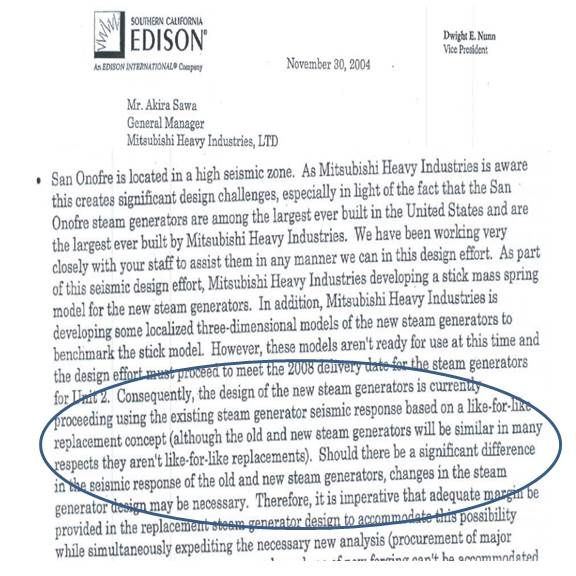Letters suggesting that the San Onofre nuclear plant operator purposely misrepresented renovations at the facility to regulators means the plant will likely not be back on-line in time to help with summer’s peak power demand.
The 2,200-megawatt San Onofre Nuclear Generating Station (SONGS), which is 78 percent owned and entirely operated by Southern California Edison, was taken offline in January 2012 after a radioactive steam leak. It was later determined the leak was due to steam generator tube wear and tear caused by inadequately performed renovations in 2009 and 2010.
Senator Barbara Boxer (D-CA) asked the U.S. Justice Department to investigate two letters written by now-retired SCE Vice-President Dwight E. Nunn to Mitsubishi Heavy Industries (MHI), the manufacturer and installer of the replacement steam generators that caused the facility’s shutdown.
In one letter, Nunn wrote that “although the old and new steam generators will be similar in many respects, they aren’t like-for-like replacements.”
Yet SCE told federal nuclear and state regulators it would use like-for-like replacements in order to avoid the time and expense of detailed hearings on the plant renovation, National Public Radio quoted Boxer as charging. “You can’t lie,” Boxer said. “You have to tell the truth.”
The letter also said there could be a “disastrous outcome” to problems encountered during the plant redesign.

Nunn, now retired, provided no comment to the media.
The company did not “hide the differences” or “mislead” regulators, an SCE statement said. The letter detailed how carefully SCE and MHI were collaborating on the new design, it added.
The Nuclear Regulatory Commission’s Atomic Safety and Licensing Board earlier this month called for a years-long re-licensing review of SONGS.
SCE wants to do a partial restart this year.
Nuclear watchdog group Friends of the Earth said in a press release that the letters and Boxer’s call for a Justice Department investigation mean the restart plan “is dead.”
The California Independent System Operator (the ISO) said the 2,200-megawatt deficit left by SONGS' absence, the unavailability of fossil units used to get through summer 2012, and economic growth that has increased peak demand by more than 2 percent all “heighten reliability concerns in Southern California this summer.”

The ISO has helped coordinate two important system improvements by state and municipal utilities that should be in place by mid-June:
- Conversion of retired Huntington Beach fossil units to synchronous condensers to provide critical voltage support
- Transmission upgrades in the Los Angeles Basin
They may not, however, be adequate to meet higher-than-expected demand during heat waves or power outages in southern Orange and San Diego counties, and the ISO warned electricity to watch for its Flex Alerts.
Normal 20 percent reserve margins are likely to drop to 7 percent in Northern California and 6 percent in Southern California. At 3 percent, the ISO said, “service interruptions could occur.”
“It is going to cost more to run San Onofre than to buy the power to replace it,” explained Center for Energy Efficiency and Renewable Technologies Executive Director V. John White. “Quite apart from the safety issue, the prudent economic thing is to recognize the plant is out of the money and it is time to move on.”
The planning is coming together to compensate for the facility’s loss, White said. “We are going to have to get down to that level, maybe even block by block, to see what we can do to get more efficiency, more demand response and more distributed technology,” White said. “If we have a bad week where it gets over 100 degrees, we are going to have to work to keep everything together.”
Success will hinge on making the grid and the system more responsive, White said. “We were not prepared for this, so we have to be more aggressive in our planning and in our voluntary actions. That means the ISO, the utilities, local government and customers large and small.”


